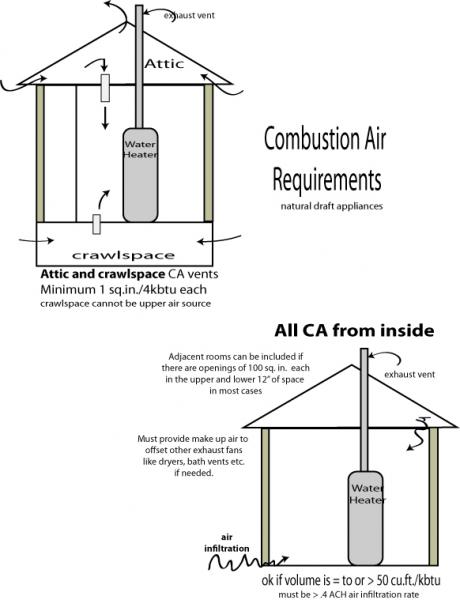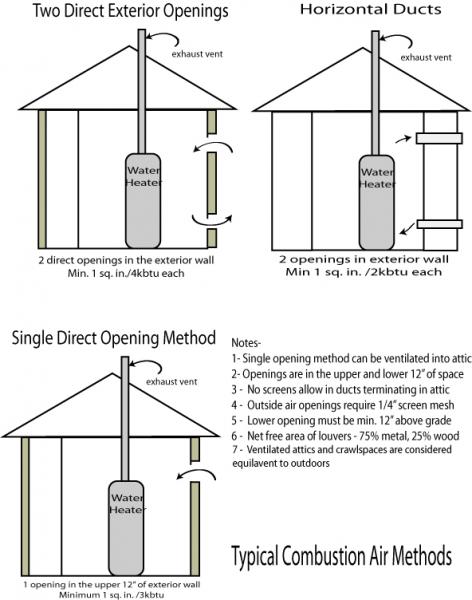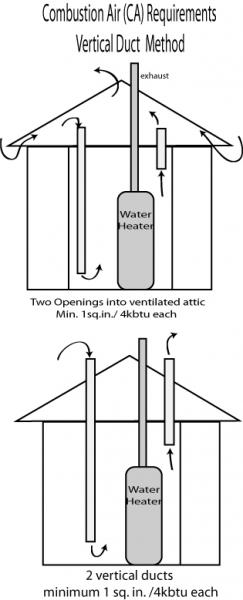- Home - Blue Palmetto Home Inspection of Summerville and Charleston
- Learn About Us and This Charleston Home Inspector
- What's Inspected
- Charleston Lowcountry Inspection Areas (geographic)
- Testimonials
- >>>Blogs (educational)
- Sample Reports & Documents
- Why Get a Home Inspection Report
- Charleston's Top Ten Reasons
- Home Inspector Photo Galleries
- Pricing
- Scheduling and Customer Information
- Home Inspection Authorization Contract
- General Scope of Work (electronic)
- Home Inspection Customer Satisfaction Survey
- Privacy Policy
- Full site
- The Roof Framers Field Manual
Moncks Corner home inspector discusses combustion air.
Submitted by Ray Thornburg on Tue, 05/14/2013 - 15:42
Combustion Air Requirements for Natural Draft Gas Appliances

To put it simply fuel burning appliances need combustion air; otherwise the flame will go out or not burn correctly which is a hazard. It needs this air not only to replace the air burned during combustion but to replace the air exhausted up the flue pipe. It's not just a performance issue. Lack of combustion air can cause issues with carbon monixide (a deadly, invisible, tasteless, odorless gas) buildup in the home.
There are a lot of rules concerning combustion air (CA) and the methods used. Basically these rules help ensure safe and efficient operation of the appliance. This discussion will focus on some of the basics. Please follow the manufacturers recommendations and any applicable codes. I used IRC 2009 2407. 1-12 for my reference.
If a gas appliance is placed in a confined space like a closet or utility room some provision must be made to supply the unit with combustion air. However if the room is large enough like a ventilated attic or double car garage it may not need additional provisions for CA. The first step is to find out the btu rating of all appliances in that space. This information is usually located on a data plate attached to the appliance. The next step is to determine the volume of the room the appliance is in (in in cubic feet). (that's LxWxH in feet) If the room is over 50 cu.ft. per 1000 btu and has a known air infiltration rate of .4 ACH (air changes per hour) then you may be good to go. Otherwise use one of the methods shown below to supply your appliance with the proper amount of combustion air.
But first let us practice a little math.
Typical gas water heater is about 40000 btu. (40K)
We have to have 50 cu. ft. per 1000 btu. so....
50 x 40 = 2000 cf
.......So we need to place this water heater in a 2000 cu ft. room (about the same size room as a one car garage) if it has a known air infiltration rate of .4 ACH (air changer per hour). If you don't know then different rules apply.
Note that any room smaller than 50 cu. ft per 1000 btu is defined as a confined space and vent holes for combustion air will have to be provided. So for our 40K btu water heater example we will need two 10 sq inch openings- one high and one low. (40K divided by 4K for each sq inch of ventilation ). A 4 inch dryer vent is 12.6 sq inches so we can use the vertical duct method to draw air from a ventilated attic. Remember both vents need to be the required size (in this case 10 sq inches).
Now lets look at different ways to satisfy combustion air requirements.
Click image to enlarge.
Click image to enlarge.
Click image to enlarge. This is probably the most popular method I see when doing home inspections.
Buildings with Unusually Tight Construction
Buildings or (spaces) with unusually tight construction must take all the combustion air from outside the thermal envelope. reference M1701.1.1
Commentary- There is no clear definition of "unusually tight construction" but most modern homes built after 1986 would meet that definition. Homes that have housewrap, double pane windows, storm window which are well sealed, and sealant applied at wall, plumbing and other penetrations would meet that definition. Also some older homes which have been remodeled may meet that definition. An air handler located in an encapsulated attic would also meet that definition so it would need combustion air ducts.
Now let's take a look at what we find out in the field.
In this picture we see two combustion air ducts in the attic area which should be extended about a foot over the insulation level. As it is now insulation was being pulled into the water heater closet and water heater drain pan. Insulation in the drain pan can easily clog the drain. In this situation a screen would not be allowed on vent openings that terminate in the attic. A high effeciency appliance itself however may require a screen for its combustion air duct (manufacturers instructions take precedence).
Occasionally we'll find a situation where combustion air ducts were closed off because either a homeowner trying to save energy or property investor didn't understand their purpose. Sometimes combustion air ducts are neglected after an appliance change out for instance. Another deficiency we find is combustion openings with clogged screens. Where screens are allowed the minimum size screen opening is 1/4".
At left is an example of how a combustion air vent can become clogged if the screen openings are less than 1/4".
Adjacent Rooms
Rooms that communicate directly with the space in which the appliance is located through openings not furnished with doors can be considered as part of the required space.
Dryers
Electric dryers don't need combustion air but all dryers need make up air. Make up air is needed to "make up" for air which is exhausted by appliances. If a dryer is in a small closet the requirement is for 100 sq inches of ventilation if the dryer can exhaust more than 200 cfm. A dryer in a small room with the door closed can suffer from reduced efficiency and the exhaust vent will be more likely to clog if make up air is not supplied. The provision for this rule is found in IRC 2012 G2439.4 (614.5).
Note* Do not place a dryer right next to a gas water heater as it can pull flue gasses back into the house. Which can cause death or sickness. Also lent will eventually clog the ventilation holes the water heater uses for proper operation and may cause the pilot light to fail. If this has to be done you'll want to provide combustion air and make up air as required.
Direct Vent Appliances
Some appliances are direct vent type and do not need combustion air because they have a built in method of drawing combustion air in through a pipe that also exhausts the flue gases. In most cases it is a type of double pipe, though sometime two separate pipes are used. A direct vent appliance will not have a single wall or double wall B vent. The manufacturer's instructions will show how to vent these appliances and supply combustion air. Many of these instructions can be obtained online. Some of these (like tankless water heaters) have conversion kits to allow for either direct vent or traditional venting methods. Always check the instructions out to see which method is best suited for your situation.




